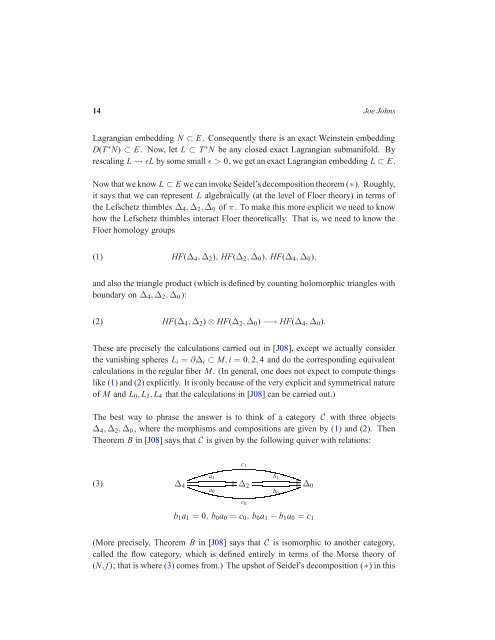The Picard-Lefschetz theory of complexified Morse functions 1 ...
The Picard-Lefschetz theory of complexified Morse functions 1 ...
The Picard-Lefschetz theory of complexified Morse functions 1 ...
You also want an ePaper? Increase the reach of your titles
YUMPU automatically turns print PDFs into web optimized ePapers that Google loves.
14 Joe Johns<br />
Lagrangian embedding N ⊂ E. Consequently there is an exact Weinstein embedding<br />
D(T ∗ N) ⊂ E. Now, let L ⊂ T ∗ N be any closed exact Lagrangian submanifold. By<br />
rescaling L ǫL by some small ǫ > 0, we get an exact Lagrangian embedding L ⊂ E.<br />
Now that we know L ⊂ E we can invoke Seidel’s decomposition theorem (∗). Roughly,<br />
it says that we can represent L algebraically (at the level <strong>of</strong> Floer <strong>theory</strong>) in terms <strong>of</strong><br />
the <strong>Lefschetz</strong> thimbles ∆4,∆2,∆0 <strong>of</strong> π. To make this more explicit we need to know<br />
how the <strong>Lefschetz</strong> thimbles interact Floer theoretically. That is, we need to know the<br />
Floer homology groups<br />
(1)<br />
HF(∆4,∆2), HF(∆2,∆0), HF(∆4,∆0),<br />
and also the triangle product (which is defined by counting holomorphic triangles with<br />
boundary on ∆4,∆2,∆0):<br />
(2)<br />
HF(∆4,∆2) ⊗ HF(∆2,∆0) −→ HF(∆4,∆0).<br />
<strong>The</strong>se are precisely the calculations carried out in [J08], except we actually consider<br />
the vanishing spheres Li = ∂∆i ⊂ M, i = 0, 2, 4 and do the corresponding equivalent<br />
calculations in the regular fiber M. (In general, one does not expect to compute things<br />
like (1) and (2) explicitly. It is only because <strong>of</strong> the very explicit and symmetrical nature<br />
<strong>of</strong> M and L0, L2, L4 that the calculations in [J08] can be carried out.)<br />
<strong>The</strong> best way to phrase the answer is to think <strong>of</strong> a category C with three objects<br />
∆4,∆2,∆0 , where the morphisms and compositions are given by (1) and (2). <strong>The</strong>n<br />
<strong>The</strong>orem B in [J08] says that C is given by the following quiver with relations:<br />
(3)<br />
∆4<br />
a1<br />
a0<br />
c1<br />
<br />
∆2<br />
c0<br />
b1<br />
b0<br />
<br />
<br />
∆0<br />
b1a1 = 0, b0a0 = c0, b0a1 − b1a0 = c1<br />
(More precisely, <strong>The</strong>orem B in [J08] says that C is isomorphic to another category,<br />
called the flow category, which is defined entirely in terms <strong>of</strong> the <strong>Morse</strong> <strong>theory</strong> <strong>of</strong><br />
(N, f ); that is where (3) comes from.) <strong>The</strong> upshot <strong>of</strong> Seidel’s decomposition (∗) in this
















